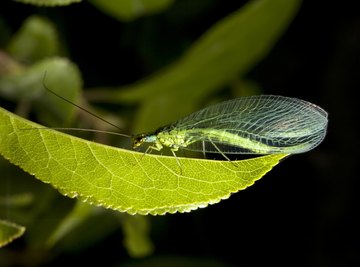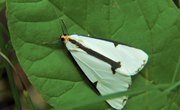
When you see tiny balls of moss crawling on a tree, you’ve stepped into the insect world’s version of "The Ugly Duckling" fairy tale. Beneath each mossy exterior lurks a green lacewing's pinkish-brown larva, the alligator-like baby of parents that appear much different. Look closely, and you’ll see a pair of curved calipers protruding from one end of the "moss" pile. Those fangs execute hundreds of plant-devouring insects before their owner pupates and emerges from its cocoon in a flash of gossamer wings and golden-eyed glory. Let the walking moss balls do their work - your tree and other garden plants will benefit from it.
Where Lacewings Come From
In order to guarantee a food source for her young, a female green lacewing deposits her eggs on or near plants covered with honeydew, the sticky waste aphids excrete while feeding. Shortly after dusk, she presses the tip of her abdomen against a leaf underside or twig and pulls it upward, releasing a one inch thread of quickly hardening silk.
After attaching a pearl-shaped egg to the top of the thread, she moves along the surface, repeating the process as she goes. By separating the eggs, she prevents her firstborn larva from cannibalizing its siblings.
How They Hide
In addition to its venom-loaded, prey-liquefying fangs, each green lacewing larva has a bristle-coated body. During its three weeks of feeding, it spears tiny bits of debris with the flexible bristles and pulls them around its soft tissues in a protective camouflage. In addition to collecting moss, bark or other plant material, it may hide beneath the husks of its prey. This habit of recycling debris and insect remains earned green lacewing larvae the nickname "trash bug."
Hiding among moss and other plant material keeps the larvae green lacewings protected from predators. According to Pacific Horticulture, adult lacewings are primarily nocturnal, which is another evolutionary adaptation to keep the species safe from birds and wasps that hunt mostly during the day. Lacewing adults are defenseless, notes the Missouri Department of Conservation, so strategies for staying out of sight are important to the survival of the species.
Adult lacewings take flight around 9:00 or 10:00 p.m., according to Mid-Atlantic Orchard Monitoring Guide. They are attracted to outdoor lights at night, so turning off porch and patio lights when they are not needed can help green lacewings stay hidden from bats and birds that are looking for a meal after the sun goes down.
What Larvae Eat
Although "trash bug" may describe a moss-covered larva's appearance, "aphid lion" is the term that best describes its appetite for other insects. Each female green lacewing lays 300 to 500 eggs, and each larva may consume 600 aphids before it pupates.
When aphids are scarce, the lacewing larva eats mealybugs, whiteflies, mites, thrips, insect eggs and even small caterpillars. After exhausting the prey on one plant, it migrates up to 100 feet to a new feeding site. Having this eating machine in your garden or orchard is beneficial.
How to Attract Lacewings
Because green lacewings fly and lay their eggs at night, you're not likely to see the four-winged, pale-green adults in your garden. Encourage their presence, though, with plenty of nectar or pollen for them to eat.
They are attracted to the open-faced, white, lavender, pink or purple blooms of cosmos (Cosmos bipinnatus) and sweet alyssums (Lobularia maritima), which are annual plants. They're also attracted to some perennials, which are plants that return year after year; those perennials include the golden-flowering, licorice-scented fennel (Foeniculum vulgare) and tickseed (Coreopsis grandiflora), which are hardy in United States Department of Agriculture plant hardiness zones 4 though 9 and zones 5 through 10, respectively. Combat the invasive tendencies of cosmos, fennel and tickseed by snipping off their spent flowers before they set seeds.
References
About the Author
Passionate for travel and the well-written word, Judy Wolfe is a professional writer with a Bachelor of Arts in English literature from Cal Poly Pomona and a certificate in advanced floral design. Her thousands of published articles cover topics from travel and gardening to pet care and technology.
Photo Credits
voylodyon/iStock/Getty Images
